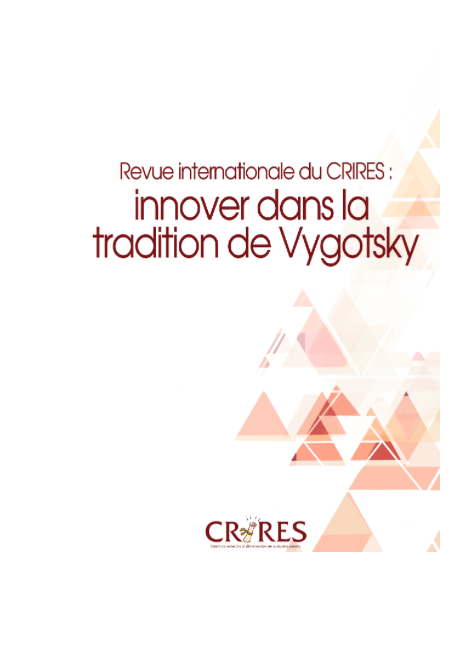Théorie historico-culturelle de l’activité, stimulation duale et conflits de motifs en sciences de l’éducation : revue de littérature (2012 – 2021)
DOI :
https://doi.org/10.51657/ric.v5i2.51287Mots-clés :
Théorie Historico-culturelle de l'Activité, Stimulation duale, CHAT, Conflits de motifsRésumé
La théorie historico-culturelle de l’activité peut être utilisée en recherche comme cadre théorique analytique. En tant que telle, c’est un cadre qui été utilisé dans une grande variété de contextes et d’objets de recherche en éducation et dans d’autres champs qui requièrent une compréhension étendue des interactions dans un système. Si d’un point de vue théorique, la relation entre stimulation duale et médiation instrumentale a été étudiée et comprise, il n’en est pas de même pour ce qui concerne le lien entre stimulation duale et conflit de motifs. Dans quelle mesure la littérature scientifique a-t-elle pris en compte cette piste de recherche ces dix dernières années ? Pour tenter de répondre à cette question, une revue systématique de littérature et une analyse thématique ont été menées afin d’identifier les thèmes pertinents. Les résultats de cette étude montrent qu’à compter du premier trimestre 2021, la littérature scientifique en sciences de l’éducation ne reflète l’intérêt et le potentiel de recherche identifiés ailleurs. La relation entre stimulation duale et conflits de motifs sont des éléments clés de la genèse de la volition et de l’action en contextes éducatifs; ces deux concepts forment donc un objet de recherche pertinent.
Références
Barma, S., Lacasse, M., & Massé-Morneau, J. (2015). Engaging discussion about climate change in a Quebec secondary school: A challenge for science teachers. Learning, Culture and Social Interaction, 4, 28-36.
Barnett-Page, E., & Thomas, J. (2009). Methods for the synthesis of qualitative research : A critical review. BMC Medical Research Methodology, 9(1), 59. https://doi.org/10.1186/1471-2288-9-59
Engeström, Y. (1987). Learning by Expanding. Cambridge University Press.
Engeström, Y. (2009). The future of activity theory : A rough draft. Learning and expanding with activity theory, 303‑328.
Kucirkova, N., Sheehy, K., & Messer, D. (2015). A Vygotskian perspective on parent-child talk during iPad story sharing : PARENT-CHILD TALK DURING iPAD STORY-SHARING. Journal of Research in Reading, 38(4), 428‑441. https://doi.org/10.1111/1467-9817.12030
Morselli, D., & Sannino, A. (2021). Testing the model of double stimulation in a Change Laboratory. Teaching and Teacher Education, 97, 103224. https://doi.org/10.1016/j.tate.2020.103224
Penuel, W. R. (2014). Emerging Forms of Formative Intervention Research in Education. Mind, Culture, and Activity, 21(2), 97‑117. https://doi.org/10.1080/10749039.2014.884137
Ploettner, J., & Tresseras, E. (2016). An interview with Yrjö Engeström and Annalisa Sannino on activity theory. Bellaterra Journal of Teaching & Learning Language & Literature, 9(4), 87. https://doi.org/10.5565/rev/jtl3.709
Sannino, A. (2015). The principle of double stimulation : A path to volitional action. Learning, Culture and Social Interaction, 6, 1‑15. https://doi.org/10.1016/j.lcsi.2015.01.001
Sannino, A. (2016). Double Stimulation in the Waiting Experiment with Collectives : Testing a Vygotskian Model of the Emergence of Volitional Action. Integrative Psychological and Behavioral Science, 50(1), 142‑173. https://doi.org/10.1007/s12124-015-9324-4
Sannino, A., & Laitinen, A. (2015). Double stimulation in the waiting experiment : Testing a Vygotskian model of the emergence of volitional action. Learning, Culture and Social Interaction, 4, 4‑18. https://doi.org/10.1016/j.lcsi.2014.07.002
Thompson, I. (2015). Researching contradictions : Cultural historical activity theory research (CHAT) in the English classroom. English in Australia, 50(3), 21‑26. WorldCat.org. Virkkunen, J., & Ristimäki, P. (2012). Double Stimulation in Strategic Concept Formation : An Activity-Theoretical Analysis of Business Planning in a Small Technology Firm. Mind, Culture, and Activity, 19(3), 273‑286. https://doi.org/10.1080/10749039.2012.688234
Zahedi, M., Tessier, V., & Hawey, D. (2017). Understanding Collaborative Design Through Activity Theory. The Design Journal, 20(sup1), S4611‑S4620. https://doi.org/10.1080/14606925.2017.1352958
Téléchargements
Publié
Numéro
Rubrique
Licence
© Guillaume Isaac, Syvie Barma, Margarida Romero 2022

Cette œuvre est sous licence Creative Commons Attribution - Pas d'Utilisation Commerciale - Pas de Modification 4.0 International.

